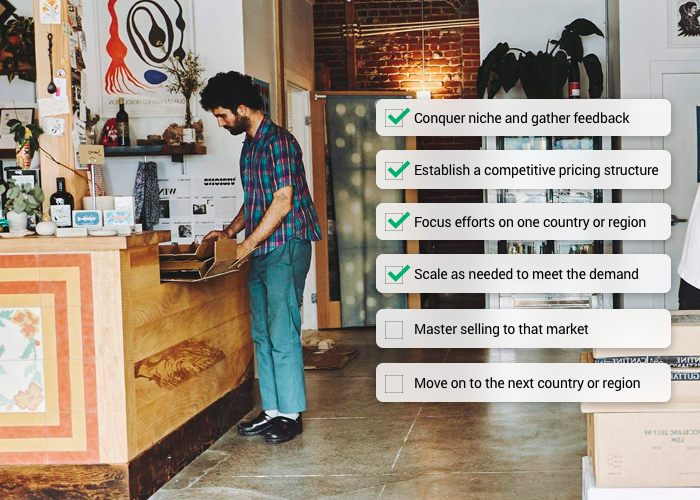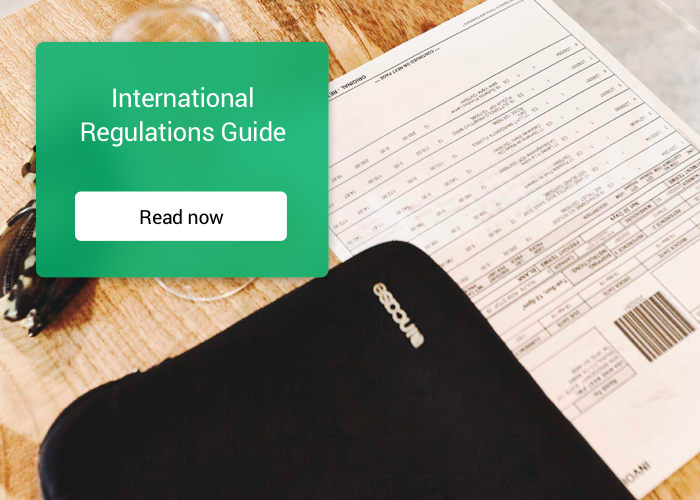Every day more people worldwide gain internet access, and even those in the most seemingly remote areas are doing their shopping online. It should come as no surprise then, that ecommerce sales are predicted to be at $3.3 trillion this year, and $5.5 trillion in 2022.
Many small businesses have already claimed a stake in these high-potential overseas markets — and with an airtight entry plan, you can be among them. Whether you’re selling hand-crocheted winter beanies or one-on-one investment advice, if you’re a small business selling online, you’re sitting on a potential gold mine.
A word of caution, however: Catering to customers around the world brings with it a new set of hurdles to clear and strategies to master. In this post, we’ll go over the preliminary steps you’ll need to take to sell abroad.
First Local, Then Global
If you’re a relatively small (or one-person) operation, there’s good reason to limit your international marketing efforts to a few select countries at first. Not only will it allow you to really get a handle on your overseas markets, but it can help you establish a competitive pricing structure.
Start by conquering your home country or niche several months before. Work out the kinks in your customer experience, and allow ample time for gathering feedback. After that, following your market research (below), strategically focus your efforts on one country or region in which you’re projected to succeed, and scale as needed to meet the demand. Master selling to that market before moving on.

Find Your Global Market
Before launching a product or business abroad, do your homework. Conduct some market research into any country/region to which you wish to expand. Three important questions you’ll need to answer are:
- Will my product appeal to citizens of that country/region?
- Is there a hole in the market I’m able to fill?
- What’s my competitive advantage in their economy?
Just as you’ve likely done your due diligence in gauging your local customers’ wants and needs, so must you acquaint yourself with your international customers — country by country. Avoid dumping time and resources into places where your product won’t resonate with people or could fail to catch on.
If you’ve noticed that customers abroad are already buying from you, do your best to figure out where the majority of your international sales hail from. Which country outside your homeland is buying up the bulk of your products worldwide? From there, do a quick risk assessment. Take into account cultural and economic standing as well as likelihood of fraud.
Finally, you’ll need to calculate and allocate a budget for marketing your products and services to your new international market segment.
Check out these resources to help you conduct international market research in an area you’re targeting.
Consider Each Market’s Preferred Payment Method
Many business owners assume that all international online payments are handled via credit card as they are in North America, Australia or Canada, but the variance is far greater. For instance, 50% of Germans use bank transfers as their preferred payment method while China almost exclusively uses Alipay, an international online payment platform akin to PayPal.
When selling internationally, you’ll do well to offer a variety of payment options. Here are the preferred payment methods by country:
- UK: Debit card
- France: Debit card
- Germany: Online bank transfer
- Finland: Online bank transfer
- Netherlands: iDeal
- Portugal: Multibanco
- Russia: E-wallet
- Switzerland: Open invoice (RatePay)
- Belgium: Debit card
- Japan: Credit card
- China: Alipay
- South Korea: Korean credit cards
- Indonesia: ATM payments
- Mexico: Oxxo
- Malaysia: Online bank transfer
Consider this: If you were purchasing an international product, would you be less inclined to buy if your preferred payment method weren’t an option? Not only would it be inconvenient, but you’d question the security of your transaction. Instilling trust and comfort is a must when appealing to foreign customers. Checkout is the number one point at which international shoppers abandoned a purchase.
Keep Tabs on International Regulations
Perhaps the most arduous part of selling online is staying up to date on the latest trade regulations. International trade regulations may vary greatly from country to country, so once you’ve decided on a particular country to focus your efforts on, it’s important to do some digging on the following:
- Tariffs
- Duties and taxes
- Customs
- Free-trade agreements
- Banned products
- Customer privacy regulations
Check out the resources below to research accurate and up-to-date regulations that may affect doing business abroad.
- Department of Commerce (US)
- Canadian Chamber of Commerce (Canada)
- NSW Fair Trading (AUS)

TIP: If you’re a U.S.-based business, consider branching out to regions such as Central America. Free trade agreements such as the Central America Free Trade Agreement (CAFTA) make international business safer and easier than ever.
Make Your Site International-Friendly
It may seem like a no-brainer, but to deliver a remarkable experience — the essence of any emerging business — you need to accommodate internationals on your website.
Allow your shoppers to browse your site in their native language or a language familiar to them. The more comfortable they are in their shopping experience, the more likely they are to buy from you.
Use localization services (below) to implement some important functionality into your website. Simply adding a language dropdown makes a world of difference. Be sure to choose one that not only auto-translates everything on your page, but one which converts date formats and addresses. The best services factor in cultural variations and currency.
Localization Services:
Another thing to keep in mind when making your site international-friendly is cultural nuances and differences. Being aware can help you to avoid any taboos or faux pas in your website copy and imagery.
Every facet of your global site must be focused on making your customers’ experience as simple and pleasurable as possible.
Procure a Global Payment Gateway and Support International Currency
If you’re going to take payments from international customers, you need a global payment gateway.
Designed for handling high-volume sales, payment gateways are cost-effective solutions designed to handle all international purchases and the majority of world currencies. Most integrate easily with any CRM or ecommerce platform. They also offer safeguards against fraud and purchase disputes.
Here are some common gateways:
Allowing customers from different countries to pay in their native currency makes it more convenient for them and, therefore, makes them more likely to purchase because they don’t need to do the math or research the current exchange rate. Thankfully, currency exchange can be handled completely by procuring a global payment gateway.
Capitalize on Global Marketing Opportunities
Black Friday and Cyber Monday are the two biggest North American shopping days of the year. What if you weren’t limited to those two national holidays for a spike in sales?
Branching out to an international market opens up tremendous holiday sales opportunities for your business. In India for instance, Diwali trumps all other shopping days. The Hindu celebration draws millions in sales of jewelry, electronics, and confectionery every year. Meanwhile Singles Day in China — a celebration of being single and spoiling oneself for the day — continues to break annual sales records each year in electronics and consumer goods. China-based Alibaba netted $5.99 million in sales in 2017 as a result of smart marketing.
Familiarizing yourself with the markets in the countries you’re targeting will serve your bottom line well.
Sort Out International Shipping (If Selling Physical Goods)
For businesses selling physical products (as opposed to digital products), you’ll want to investigate the cost, speed and reliability of shipping services to any countries or regions you’re targeting.
For a list of reliable international carriers to choose from, as well as their rates, visit this page. A shipping calculator such as this will help you estimate your shipping costs to any given country.
As an international vendor you must set clear delivery expectations. Keep in mind the shipping duration for international packages is longer, and list delivery estimates on your website to avoid customer confusion.
Above all else, be sure that your profit margin from selling abroad covers your “landed cost.” That’s the total cost it will take for your product to reach its final destination: the customer’s doorstep.
